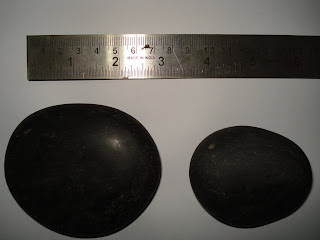


Basanite or more commonly referred to as Lydian stone, touch stone, lydite or kasauti, is an igneous, volcanic (extrusive) rock withaphanitic to porphyritic texture.
Not to be mistaken with Bassanite which is a saline evaporate consisting calcium sulphate, found at Vesuvius, Italy.
Minerology: The mineral assembly is usually abundant feldspathoids (nepheline or leucite),plagioclase, and augite, together with olivine.Clinopyroxene (augite) and olivine are common as phenocrysts and in the matrix. Quartz is absent, as is orthopyroxene. Some basanites have been the source of sapphires or rubies.
Texture: Aphanitic to porphyritic texture. The rock is hyalopilitic in thin section texture.
Configuration: Chemically, basanites are low in silica (42 to 45% SiO2) and high in alkalis(3 to 5.5% Na2O and K2O) compared to basalt, which typically contains more SiO2. Unlike basalts, basanites are rich in olivine minerals.
Whereas Basalts are extrusive igneous rocks that are that are low in silica content, very dark in color. They are the most common type of rocks in the Earth's crust and they make up most of the ocean floor.
Mineralogy: The mineralogy of basalt is characterized by a preponderance of calcicplagioclase feldspar and pyroxene. Olivine can also be a significant constituent. Accessory minerals present in relatively minor amounts include iron-oxides and iron-titanium oxides. Because of the presence of such oxide minerals, basalt can acquire strong magnetic signatures as it cools, and paleomagnetic studies have made extensive use of basalt.
Texture: Aphanitic to porphyritic texture. The rock is Ophitic in thin section.
Table comparing Basalt and Basanite Rock Chemistry.
Oxide | Basanite | Basalt |
SiO2 | 44.3wt% | 45-55 wt% |
TiO2 | 2.51 wt% | 0.5-2.0 wt% |
Al2O3 | 12.8 wt% | 14 wt% |
FeO | 11.4 wt% | 5-14 wt% |
MgO | 11 wt% | 5- 12 wt%. |
CaO | 10.5 wt% | 10 wt% |
Na2O + K2O | 5.65 wt% | 8 wt% |
Basanites occur both on continents and on ocean islands. For example, together with basalts, they are produced by hotspot volcanism.
Uses:- Basanites are highly resistant to corrosive acids viz. nitric acid, sulphuric acid and aqua regia, because of this quality Basanites prove themselves very useful in chemical analysis of jewelry. Their abrasive nature helps in making a streak of the metal to be assayed and their dark color is of contrast to the streaks of gold, silver and platinum etc.
For assaying the purity of a metal, first a streak of the metal is made on the stone, and then the streak is made to react with acid solution of 78.4% nitric acid, 1.6% hydrochloric acid and 20% water, which is applied carefully with the help of a glass rod. The following results are obtained for respective metals.
Ø Gold (Pure):- No change because no reaction occurs. (Golden Streak Intact).
Ø Gold (Impure/Alloyed):- The acid solution dissolves the impurities (possibly copper and silver) leaving the gold streak intact. The amount of pure gold in the alloy can be estimated by analyzing the amount of streak washed away.
Ø To Distinguish between Silver and Platinum: - Same as above for gold the acid dissolves Silver but doesn’t react with Platinum.
The method stated above is not as accurate as fire assay but is the most prevalent method to assay gold items of unknown quality and configurations.
Discovered by the Egyptians this was used as the first method of assaying gold and was used at least as early as 500 BC.
Where do I buy a touch stone
ReplyDelete